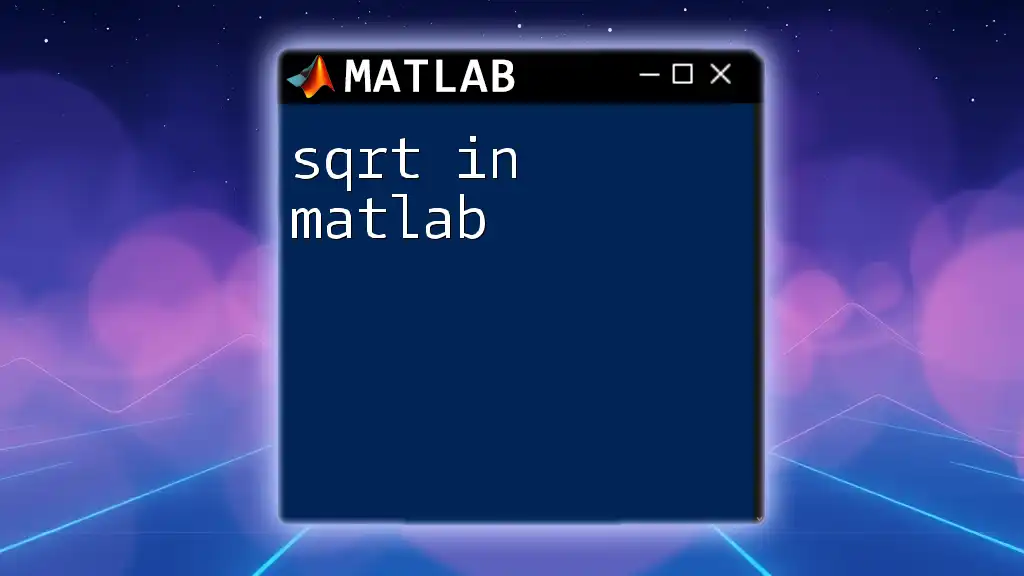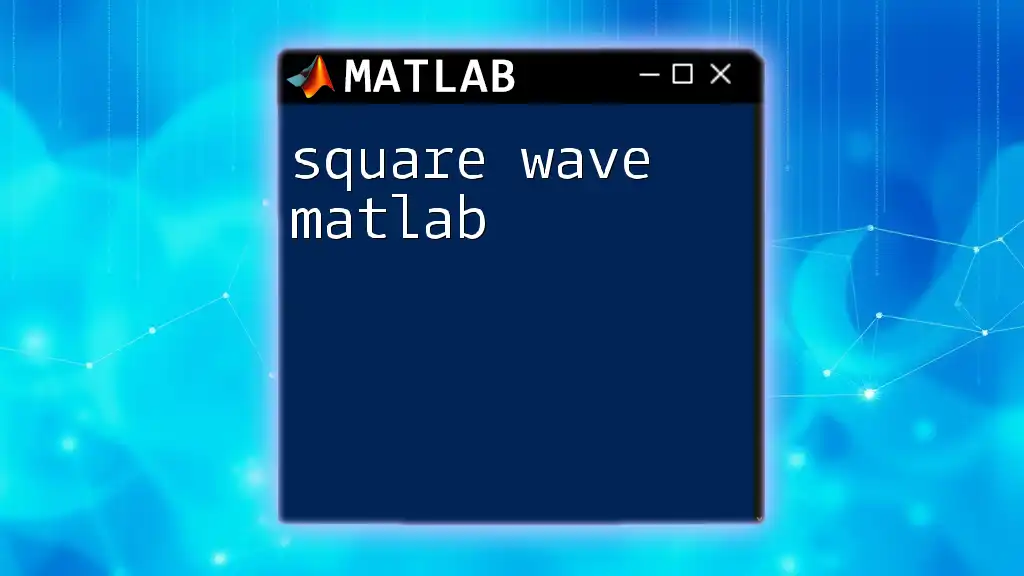In MATLAB, you can calculate the square of a number or array by simply using the `.^` operator to perform element-wise squaring.
% Square a number
number = 5;
squaredNumber = number^2;
% Square an array
array = [1, 2, 3, 4];
squaredArray = array.^2;
Understanding the Basics of MATLAB
What is MATLAB?
MATLAB, short for "Matrix Laboratory," is a high-level programming language and interactive environment that specializes in numerical computing, data analysis, and visualization. It provides a wide range of built-in functions and tools, making it an invaluable resource, especially for engineers, mathematicians, and scientists.
Why Use MATLAB for Geometric Shapes?
MATLAB excels in graphical representations due to its powerful plotting capabilities. Understanding shapes like the square in MATLAB is fundamental for effective data visualization, modeling, and graphical outputs, which pave the way for applications ranging from academic research to real-world engineering problems.

Creating a Square in MATLAB
Defining a Square
Before diving into coding, let's clarify what defines a square. A square is a four-sided polygon (quadrilateral), where all sides are of equal length and every angle is a right angle (90 degrees).
Using MATLAB Commands to Create a Square
Drawing a Square with `rectangle()`
One of the simplest ways to draw a square in MATLAB is by using the `rectangle()` function. This function allows for the creation of rectangles and squares easily by specifying the position and size attributes.
The syntax for using `rectangle()` is as follows:
rectangle('Position', [x y width height])
- Position: The lower-left corner of the rectangle.
- Width: The width of the rectangle (length of one side of the square).
- Height: The height (which is equal to the width for a square).
Example Code:
figure; % Open a new figure window
rectangle('Position', [1, 1, 2, 2], 'EdgeColor', 'b', 'LineWidth', 2);
axis equal; % Ensures the square appears correctly
title('Square using rectangle() function');
In this case, we create a square that starts at the point (1, 1) on the coordinate system, extending 2 units in both width and height. The edge color is blue, and the line width is set to 2.
Using `fill()` for a Solid Square
If you want to create a filled square rather than just an outline, you can use the `fill()` function. This function enables you to specify the vertices of the shape along with its color.
The syntax for the `fill()` function is:
fill(X, Y, C)
- X: The x-coordinates of the vertices.
- Y: The y-coordinates of the vertices.
- C: The color of the filled shape.
Example Code:
x = [1 3 3 1]; % x-coordinates
y = [1 1 3 3]; % y-coordinates
figure;
fill(x, y, 'r'); % Creates a red filled square
axis equal;
title('Solid Square using fill() function');
Here, we specify the corners of the square in the `x` and `y` arrays. The square is filled in red, and the command `axis equal` maintains the aspect ratio in the graphical output, ensuring the square appears proportional.

Modifying Square Appearance
Changing Colors and Edge Styles
Customizing the appearance of squares can enhance visual clarity. You can alter properties such as color, edge style, and line width.
Example Code:
figure;
rectangle('Position', [1, 1, 2, 2], 'EdgeColor', 'g', 'FaceColor', 'y', 'LineWidth', 3);
axis equal;
title('Custom Square Appearance');
In this example, the square now has a green edge color, a yellow fill, and a line width of 3, making it visually distinct.
Adding Annotations and Titles
Proper labeling enhances understanding. Adding titles and text labels to your shapes can communicate the functionality or represent the context better.
Example Code:
figure;
rectangle('Position', [1, 1, 2, 2], 'EdgeColor', 'b');
text(2, 2.2, 'This is a square', 'FontSize', 12, 'Color', 'k');
axis equal;
title('Square with Annotation');
In this code snippet, a text label is placed above the square using the `text()` function to provide clarity about what is being represented.

Creating Multiple Squares
Looping to Generate Squares Programmatically
Using loops allows for efficiency when you need to create multiple squares. This is particularly useful in scenarios involving data output or simulations.
Example Code:
figure;
hold on; % Allows multiple squares to be drawn
for i = 0:4
rectangle('Position', [i, i, 1, 1], 'EdgeColor', rand(1,3)); % Random color
end
axis equal;
title('Multiple Squares in a Loop');
In this example, a loop generates five squares in different color shades, demonstrating how easy it is to automate repetitive tasks in MATLAB.
Arranging Squares in a Grid
If you want to display squares in a structured format, nested loops are powerful tools.
Example Code:
figure;
hold on;
for i = 0:2
for j = 0:2
rectangle('Position', [i*2, j*2, 1, 1], 'EdgeColor', 'b');
end
end
axis equal;
title('Squares Arranged in a 3x3 Grid');
This code produces a 3x3 grid of squares, spaced evenly, showcasing the arrangement capabilities of MATLAB.

Advanced Visualization Techniques
Using Patch for More Complex Squares
When it comes to creating more complex shapes or polygons, the `patch()` function can be utilized. This is especially useful for irregular squares or multi-colored polygons.
Creating a 3D Square
To extend your understanding of shapes further, exploring 3D graphics is beneficial. The `fill3()` function can create squares in a 3D space.
Example Code:
figure;
x = [0 1 1 0];
y = [0 0 1 1];
z = [0 0 0 0];
fill3(x, y, z, 'c'); % Cyan square on the xy-plane
title('3D Square Using fill3() Function');
This code creates a cyan square within the 3D space, utilizing the `fill3()` function to add depth to your visualizations.

Conclusion
Understanding how to create and manipulate a square in MATLAB opens up a wealth of possibilities in data representation and visualization. By leveraging commands like `rectangle()`, `fill()`, and advanced functions, one can create visuals that not only convey information more clearly but also engage the audience effectively. Experimenting with these techniques can lead to richer visual outputs that further enhance your projects and presentations.

Additional Resources
For more in-depth knowledge, exploring MATLAB's built-in functions and official documentation can provide additional tools and insights into geometric shapes and graphical representations.

Call to Action
We encourage readers to share their experiences and creations with squares in MATLAB. Don't forget to follow our blog for more concise tips and tricks on mastering MATLAB commands!

















